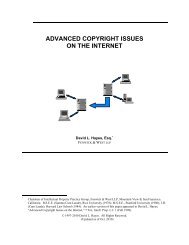Paramount Pictures Corporation v. ReplayTV, Inc., Joint Stipulation ...
Paramount Pictures Corporation v. ReplayTV, Inc., Joint Stipulation ...
Paramount Pictures Corporation v. ReplayTV, Inc., Joint Stipulation ...
You also want an ePaper? Increase the reach of your titles
YUMPU automatically turns print PDFs into web optimized ePapers that Google loves.
12345678910111213141516171819202122232425262728unlawful behavior” is incorrect as a matter of fact and law. As a matter of fact, ifPlaintiffs really wanted documents to assess whether Defendants have designed theproduct to prevent potential infringement, Defendants have already agreed toproduce them. Defendants will produce documents showing “ Defendants’ effortsto design, format, or structure the <strong>ReplayTV</strong> 4000 to limit or prevent” allegedinfringement (see Defendants’ Response to Requests Nos. 5, 6) and havespecifically agreed to produce documentation of communication amongmanagement and decision making on these issues.More fundamentally, as a matter of law, Plaintiffs are wrong in suggestingthat the ability of a manufacturer to develop a different product, that might allow orrestrict copying in different ways, affects the analysis. Plaintiffs apparentlyadvocate a regime in which owners of copyrighted works have the right to oversee,and veto, technologies that are not developed to provide all of the features, orcalibrate their deterrence of theoretically infringing uses, in the method that thosecopyright owners desire. No case has ever provided copyright owners the ability todictate the content of new technologies. 17/The Sony decision stands for precisely the opposite proposition. See SonyCorp. of Amer. v. Universal City Studios, <strong>Inc</strong>., 464 U.S. 417, 104 S.Ct. 774 (1984).There, the Supreme Court emphasized that copyright law grants only a limitedstatutory monopoly (id. at 429-432); it does not grant the copyright holder theability to redesign a new technology. Thus, to prevent infringement, Sony couldPlayboy Enterprises, <strong>Inc</strong>. v. Webbworld, <strong>Inc</strong>., 991 F. Supp. 543 (N.D. Tex.1997) is distinguishable. There, the district court did not address vicarious liabilityor the consideration of alternative designs for purposes of determining “ control.” Itfound direct liability against the provider of an Internet site that sold copyrightedimages without authorization. The court predicated liability on defendant’ saffirmative conduct of actively copying images with its software to repackage andsell to users of its services. Id. at 552. The court held that where the defendantitself was actively copying and reselling copyrighted works, it could not defendbased on the inaccuracy of its own software in identifying copyrighted works. Thatopinion hardly makes alternative designs relevant to the vicarious liability claimhere.17/27
















